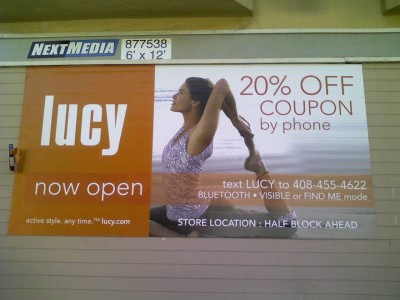
BlueFire Digital has provided mobile marketing platforms for out-of-home (OOH) advertising, including traditional static billboards. Photo courtesy BlueFire Digital
Also in 2010, the Canadian Tourism Commission (CTC) launched a promotional campaign in the U.S. that used social media and user-generated content to create Twitter-based ‘storescape murals,’ featuring a stream of photos, videos and conversations relating to Canadian cities, cultural experiences and vacations. Developed by ad agency DDB Canada, the campaign encouraged Canadians and Americans alike to interact with the digital billboards, including passersby who could use them as touch screens.
In this case, digital signage was an outgrowth of CTC’s extensive social media efforts, as well as part of a broader campaign that included TV and radio ads. The idea was to highlight unique, compelling qualities of Canada to American travellers.
Response was positive, with 97 per cent of participants becoming followers of CTC’s Twitter feed, 20,000 people actively tweeting during the campaign, 5,000 photos posted, 40,000 views of CTC’s YouTube vacation travel programming and a total of five million impressions.
Stumbling blocks
Nevertheless, the medium still faces some challenges. Lockhorn cautions against “overloading consumers with more ad clutter.”
King at LocaModa agrees.
“Consumers have been bombarded for so long by passive media, they tend to block out advertising altogether,” he says. “The key challenge is conveying to the customer that this kind of experience is in fact interactive.”
Another stumbling block in the past has been a paucity of technology to properly integrate mobile devices with digital signage. Specialized companies have developed a wide array of products to fill the gap.
“Mobile-driven digital signage marketing campaigns are currently limited in their reach, requiring the marketer to balance scale versus impact,” says Lockhorn, “but as technology standards continue to emerge, the scale will come. Marketers who experiment today will be in a stronger position once that scale is achieved.”
He also points out the effectiveness of an interactive technology in a public setting will depend on the environment where it is applied. An application that works well in an airport, for example, may not be suitable for a coffee shop.
“Also, it’s not clear these techniques are well-accepted by a majority of advertisers,” says Steven L. Gurley, senior vice-president (SVP) of global marketing and business development for Symon Communications, which develops software for digital signage, information kiosks and other media. “Some are resistant to these techniques because they often focus on small audiences. And a significant number of advertisers are confused and threatened by the new mobile landscape.”
According to Donna Boyer, a manager for Reach Media Networks, advertisers and marketers should into account the strengths and weaknesses of different forms of interactivity.





